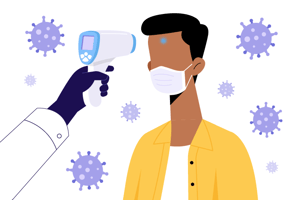According to a new McKinsey report, the worldwide healthcare response to COVID-19 will remain a priority for the next 18 to 24 months, as countries work to suppress the virus, expand their testing and treatment capacities, and research therapies. Tangentially, healthcare leaders will also need to adjust to a post-COVID-19 next normal, adapting and accelerating their work in the face of new challenges.
McKinsey has identified three key shifts coming across the delivery of healthcare, particularly applicable in the Middle East, Africa and Asia:
1. New paradigms for infrastructure, the geographic distribution of providers, and care settings
How hospitals are constructed will continue to remain a prime focus, with designs that maximize the control of infection spread and the ability to convert regular beds to intensive care beds continuing to be of importance. Healthcare facilities with large footprints and strained intensive care units may also establish centralized intensive care hubs of excellence, with concentrated healthcare expertise offering the opportunity to leverage remote monitoring technology. The world may also see a shift towards virtual ICU models, such as the one at Mercy Hospital in Australia, where patients are at home and intubated with a nurse in attendance while critical care specialists monitor remotely.
In the next normal the delivery of elected care will occur in dedicated areas within hospitals where COVID-19 patients are managed or in dedicated non-COVID-19 facilities, while virtual care supplemented with artificial intelligence may also become the norm. McKinsey also predicts a massive expansion of home-based care and virtual care via AI, phone-based diagnostics, and other virtual patient engagement platforms. Finally, we will also see an accelerated transition to ambulatory care and day surgery, so that patients may avoid hospital stays wherever feasible.
managed or in dedicated non-COVID-19 facilities, while virtual care supplemented with artificial intelligence may also become the norm. McKinsey also predicts a massive expansion of home-based care and virtual care via AI, phone-based diagnostics, and other virtual patient engagement platforms. Finally, we will also see an accelerated transition to ambulatory care and day surgery, so that patients may avoid hospital stays wherever feasible.
2. Operational excellence - critical in the next normal
Revenue growth in the healthcare sector may be challenged for a prolonged period, driven by the overall pace of the economic recovery and specific trends related to private providers. At the same time, a new set of labor costs may rise in some markets as healthcare worker shortages continue to emerge, particularly in critical care disciplines. Capital expenditure costs also may increase as providers build larger networks or undertake necessary upgrades to existing facilities, while costs around inventory will also escalate as providers implement more stringent requirements on safety stocks of PPE and other consumables. Providers may also need to develop new capabilities in inventory management.
3. The emergence of new growth opportunities and diversification
In the post-COVID-19 next normal we will see the emergence of new growth opportunities and diversification, according to McKinsey, with healthcare providers seeking telehealth consultations, home healthcare services, non-ER-based primary community care, and more proactive regular health screening. We will also see new and innovative arrangements between the private and public sectors in many countries, such as the Australian government’s partnership with the private sector to utilize their capacity to manage anticipated public demand.
Adjusting to the Next Normal:
For the key shifts in healthcare models described here to occur, we will also need to adjust reimbursement and regulatory models, patient behavior and technological advancement. According to McKinsey, greater flexibility in reimbursement models will be needed, particularly for telehealth and home healthcare services. Changes in the regulatory realm will also be required, with new licensing skill measures for healthcare workers, a shift to real-world evidence in clinical trials and the development of new frameworks as activities shift to out of hospital care. We will also need to see a shift in patient behavior, with patients demanding a seamless technology experience irrespective of the care setting. Finally, adjusting to the next normal will require technological advancements, including AI-based diagnostics, cloud-based storage of records, digital tools to facilitate remote communication between providers and patients and home-based monitoring devices continuing to be developed and improved.
As we continue to witness the spread of the coronavirus worldwide, pressure facing healthcare institutions also increases. With the spread of the virus comes the development of new initiatives that will continue to support healthcare providers in treating patients now, and in the next normal phase of the healthcare evolution.
Learn how BookJane helps health care facilities improve shift fulfillment by 40%, dramatically decrease their time to fill shifts, and significantly reduce burdensome scheduling and administration time.





